To visit Kanchanuburi, one must take a trip back in time to it's not too distant past. The WW2 that took place in this part of the world has created a human tragedy not unlike any war tragedies around the world. Central to this is a railroad that connects Thailand to Burma and in particular, a bridge over a river that was romanticised in this war film, The Bridge on the River Kwai.
On 7th December, 1941, Japan surprised attacked on American naval force at Pearl Harbour sparks the beginning of the Japanese assault of South East Asian countries. In lightning speed, Japan attacked the following countries in succession
8.12.41 - invaded Thailand by sea ,air and land from Battambang, Cambodia. invaded Malaya from Kota Baru and sinking Repulse and Prince of Wales battleship Malaya and onwards to Singapore.
10.12.41- Landed at Luzon, Phillipines and took over Guam.
16.12.41- took control of Borneo, including Brunei.
22.12.41- Landed Mindanao and Wake Island.
- attacked Celebes and reach Amboine
May '42- Invaded Burma
To feed it's troops based in Burma, Japan decided to construct a railway line from Kanchanaburi, Thailand to Thanbyuzayat in Burma to ferry supplies and provide necessary support. The construction of that rail link started on 16.9.42 and was estimated to take five years. But under tremendous pressure to complete it in a year, the timeline was forced on the workers "recruited". These were the prisoners of war ( POWs ) transferred from Changi goal and elsewhere to the project site in Thailand. They included British, Dutch, Americans and Australians POWs and there were 61,000 of them in total. In addition, 200,000 Asian workers, mostly Chinese and Indians from Malaya, Singapore and Burma were conscripted or coerced to what is now known as the "death railway". The working condition was a hell on earth for those unfortunate souls. Lodging was at best an open shed, working hours almost non stop, food inadequate and fit for animals, sanitary issues were prevalent due to lack of proper toilets and tropical disease like malaria and cholera were rampant. In a span of 16 months when the railway was completed, 100,000 Asian workers and 16,000 allied soldiers perished. Those that survives were ill, malnourished and had lost so much weight that they were literally walking skeletons! The whole tragic history was encapsulated in the Award winning war movie entitled "The Bridge on the River Kwai." This movie was released in 1957, although an old movie and a fiction, the background is based on real places and history.
The whistling tune is the theme song from the 1957 award winning war movie called "The Bridge on the River Kwai". It was the song we always hear in our childhood days and has popularise the bridge that was part of the construction of the infamous railway line from Kanchanaburi to Thanbuzayat.
It is this place in Thailand we visited during our annual pre-CNY holidays from 8.2.18 to 11.2.18.
A dip at the Erawan Fall.
Our flight arrived 9.00 am in the morning. The plan was to go straight to Kanchanaburi from Don Muang Airport. Thereafter, we would spend a day relaxing at the waterfall at Erawan National Park.
On the way to Kanchanaburi, we stopped at a coffee outlet for a break.
We finally arrived at our resort after 3 hours on the road.
Felix River Kwai Resort is an old resort still popular with tourist.
The entrance have the old traditional Thai architecture.
It's low season and there weren't many tourist when I register at the hotel reception.
The receptionists were very helpful.
Even though they could communicate in English, there could still be some miscommunication. However, that is not a major problem.
After checking in, we asked our driver to recommend us local food. He promptly took us to the tourist market where there are some food stalls. It was already 2.00 pm and we had wantan noodles, Thai style. The operator is of Teochew descent. After our simple lunch, we headed straight for the Erawan National Park
. This is our spacious van which can packed in 10 pax. We had a lot of space to ourselves as there are only four of us.
At the entrance of the National Park.
It was about a kilometer walk to the waterfall.
The cascading rapids along the way in.
Casey taking a photo at one of the rapid spot.
Signage to indicate you are in the park.
We arrive at the level where many tourists were enjoying themselves at the waterfall.
It was so inviting that we wasted no time jumping in.
Lilian came prepared to have a dip at this natural surrounding.
Stephen soon joined us and swam straight to where the fall is.
Ya, you feel energise just to be with nature.
She prefers to cool herself over this side.
Stephen and I enjoying the water falling around us.
Casey was engrossed in taking photographs all along the way and arrive when we were already frolicking in the water.
How could he resist.
That's the favourite spot to be.
He was shouting to me to take that photo for him.
Stephen diving in, must be years since doing this at the "Pasir Cowboy"river back home.
This is only the second level There are in total 7 levels of waterfall, but this one seems to be more popular with tourists.
The War Museum and Art Gallery.
In Kanchanaburi town, the places of interest all relates to the atrocities during the wartime. Our first visit was The War Museum and Art Gallery situated right next to the bridge.
The entrance of the museum looks anything but a museum.
The center courtyard stands a structure and some statues with no theme.
On the right hand side, there's a signage that amplify what I have stated at the very beginning.
The train that was used by the Japanese during the war is on display in it's natural state.
Here is the full size of the locomotive.
Inside a section of the museum are weapons used by the Japanese foot soldiers. The picture here shows the actual rifles left behind.
An array of Japanese swords are also on display.
These are the basic weapons used to control the POW labourers.
The Japanese had earlier invaded Thailand by land from Battambang, Cambodia. They simultaneously attacked from the air at Don Muang Airport and from the sea via amphibious landings at Hua Hin on 8.12.1941, the same day when they attacked Malaya. Thai Premier Field Marshall Phibun Songkhram sees the futility of resisting the attacked and signed a formal treaty of alliance with Japan on 21.12.1941. Without doubt, Thailand had no option, and with that treaty, Thailand is no more neutral as earlier declared, and becomes an ally of Japan. With this "cooperation", the Japanese was able to use Thailand as a supply route over land to Burma and avoid the sea route.
This is the railway route that was to be built to connect Kanchanaburi to Thanbuzayat, Burma. The project was abandoned by the British earlier as it would have to trespass difficult and "unpassable" mountainous terrains.
This was the bridge over the River Kwai at Kanchanaburi.
It was popularise by a war movie relaesed in 1957 entitled " The Bridge over the River Kwai."
Despite the British engineers estimate, the Japanese put a time frame of one year to have the bridge build.
61,000 allied POWs and 200,000 Asian labourers were forced to build the railway in record time.
The railway was eventually completed in 16 months.
The horror was the unhygienic and slave like environment the workers have to endure.
16,000 allied soldiers and 100,000 Asian labourers perished during that 16 months construction.
Towards the end of the war, the bridge was bombed twice by the allied forces.
The movie that popularise this bridge have replicated the location at Sri Lanka and have is's own fictional version of the war.
The Bridge on the River Kwai.
The bridge is just a 100 meter walk from the museum. At a glance, it is just like any other old railway bridge, but if you know the history, the bridge looks alive.
The bridge can be viewed from the restaurant by the river.
There are day tours from Bangkok and also school children when we walked over in late morning.
Casey took a selfie of the bridge.
The crowd dissipated by midday.
Lilian took the opportunity to have her picture taken.
Stephen's "stylo milo" pose.
The view from the bridge.
Yes, this is the historic bridge.
The steel columns were dismantle and shipped in from Surabaya during construction.
The steel bridge had eleven spans when it was built in 1942.
Three spans were bombed by the allied soldiers during the war.
The railway is now managed by the State Railway of Thailand and is in use, but not all the way Thanbuzayat.
This quaint little shed is at the other end of the bridge.
It's 350 meter from this point to the other end.
Casey standing at the other side with the view from below the bridge.
Nearby is a monument erected in memory of Chinese soldiers that died there. There is no account of Chinese soldiers being brought here but certainly there are Chinese labourers conscripted from South East Asian countries.
It is isolated and stood behind a shed with rubbish being strewn around it. Such an undignified position.
The Kanchanaburi War Cemetry.
Along the main road that run through the center of town, one would not missed passing by the Kanchanaburi War Cemetery. This cemetery is erected in memory of the war prisoners that died here and the site is maintained by the Commonwealth War Graves Commission.
The cemetery is located along the main road.
It is maintained by the Commonwealth War Graves Commission.
The plaque at the inside entrance of the cemetery.
The final resting place of 6,892 allied soldiers, mostly from Australia, Britain and The Netherlands.
The neat, tidy and well manicured cemetery stood in contrast to the Chinese Soldier Memorial seen at the far end of the River Kwai Bridge.
Any tourist that visits The Bridge at River Kwai will come here. One immediately feel the tragic reality that took place at this very village four scores ago. The cemetery is a solemn place that ensures the sacrifice made by these soldier are not forgotten.
The neatly laid out gravestone and well maintained lawn.
 A close up look at the inscriptions makes one shudder. These are all young lads whose lives are cut short by the war. One wonders the untold sufferings they had to endure during the railway construction before they breath their last breathe.
A close up look at the inscriptions makes one shudder. These are all young lads whose lives are cut short by the war. One wonders the untold sufferings they had to endure during the railway construction before they breath their last breathe. I penned the Visitors book before leaving.
It is at the last row of the page.
My brothers too sign the book, Stephen wrote at the first row and Casey's entry was the last row of the following page.
Reading about the war and coming here to see it is two different thing. I have intentionally chose to come to Kanchanaburi, to see for myself the place where the tragedy occured. After seeing the gravestones in memory of those young soldiers that died here thousands of miles away from home and knowing how they died, I left the cemetery with a heavy heart.
At the same time, I have some trouble thoughts upon leaving Kanchanaburi. There were on records 100,000 Asian workers that also perished while working here. The big question is what happened to those people? Why isn't there any memorial for them ? Are they less of a human being or being civilians are of no concern to anybody? Despite greater numbers of casualties, no effort is being made to know more of their tragedy. The Thai authorities have paid tribute to the allied soldiers in a plaque at the War Cemetery, what about their Asian brethren ? The Commonwealth War Graves Commission maintains the graves only for allied soldiers ? What about the Asian civilians ? The only memorial I saw was the one at the far end of the bridge for the Chinese soldiers. I am not sure who erected that and whether there were any Chinese soldiers consrcripted over here during the war. But even that was left standing next to a rubbish dump in an unkempt environment. It is clear that the Commonwealth Commission in their total disregard for the bigger Asian casualties have no common values for all Commonwealth nations.
The JEATH War Museum.
Close to the River Kwai bridge is another museum with an unusual name. The word JEATH is actually an acronym for Japan, England, Australia, Thailand and Holland. The "A' also refers to American. It is founded and managed by the Buddhist temple next to it.
Wat Chaichumpol temple is just beside the JEATH Museum and manages it.
It is build to prove information to the tourist about the experiences of those who worked in the Thai Burma Railway and to commemorate those who lost their lives along the way.
The signage just inside the museum.
The museum consist of paintings, drawings, old photos, memorabilia of soldiers.
The museum is housed under reconstructed bamboo huts that resembled those that was the abode of the soldiers.
The map of the Thai Burma Railway at the compound.
The various stops of the entire railway line from Kanachanaburi to Thanbuzayat.
A close up look of a section of the map.
No photography is allowed inside the museum. So we took a group photo at the entrance. The museum provides the some basic insight of the war times but does not live up to the standard of a proper museum.
We left Kancahnaburi for Bangkok after coming to see what we want to see. For a history buff, this is a must visit itinerary.















































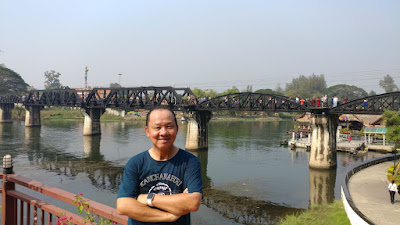



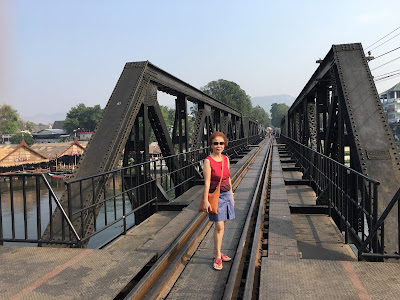
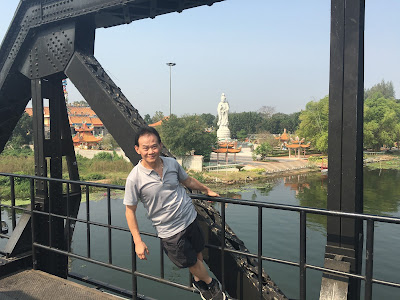





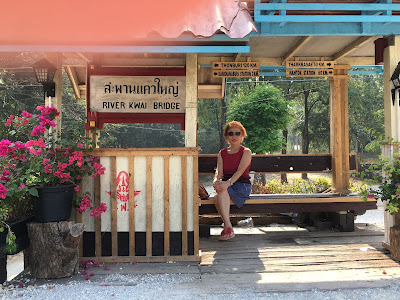

























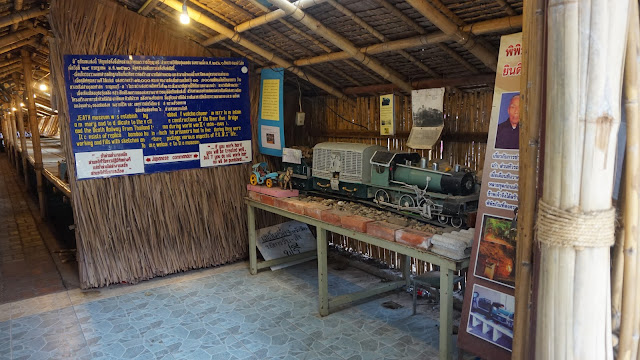




No comments:
Post a Comment